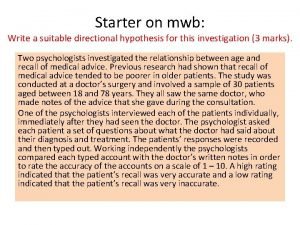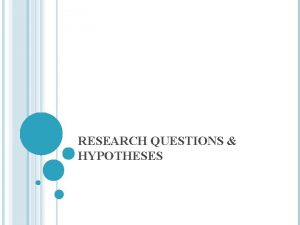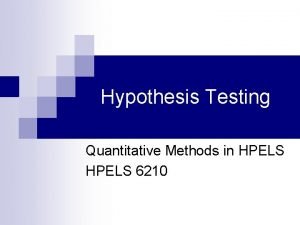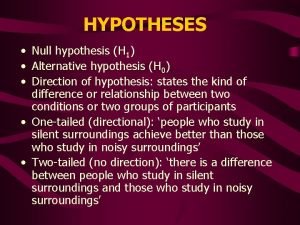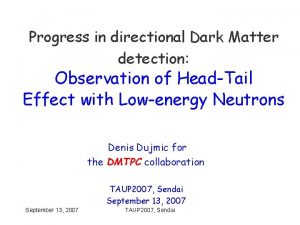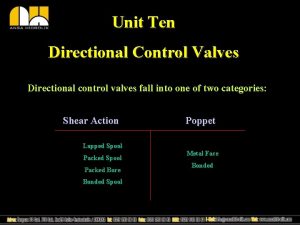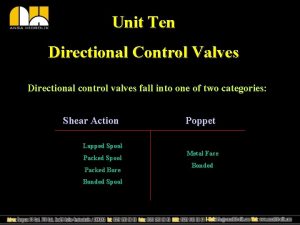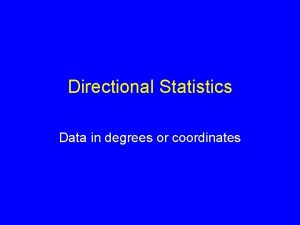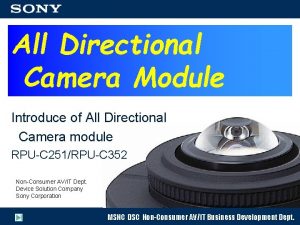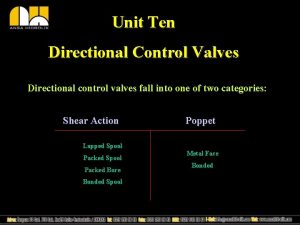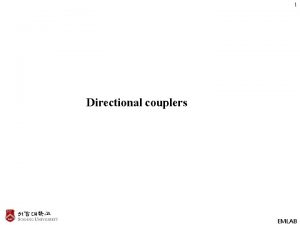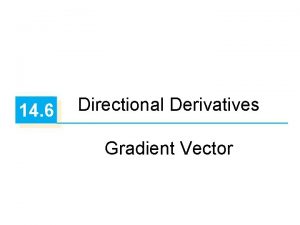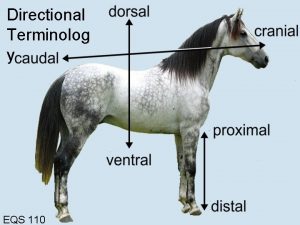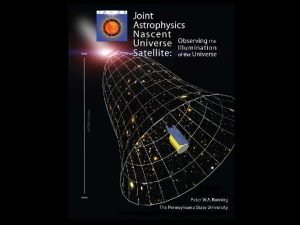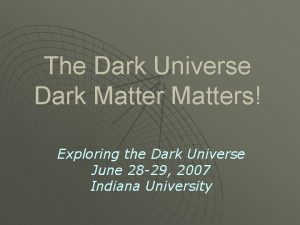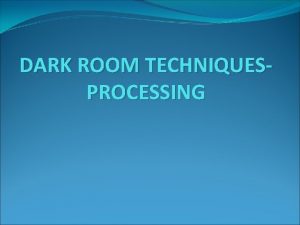Recent Progress on D 3 The Directional Dark


































- Slides: 34

Recent Progress on D 3 The Directional Dark Matter Detector • • • Detection Principle Motivation Prototypes constructed Their performance Next steps alpha particle track detected with latest detector prototype Sven E. Vahsen, University of Hawaii CYGNUS 2015 Sven Vahsen (U. Hawaii) 1

D 3 - Directional Dark Matter Detector • • Investigating feasibility of directional DM search w/ micro-pattern gas detectors Technology also of interest for detecting neutrons and charged particles Small (1 -60 cm 3) prototypes built at LBNL and U. Hawaii Ongoing since ~Fall 2010 Berkeley Lab Hawaii LBNL Hawaii D 3 - micro CYGNUS 2015 Sven Vahsen (U. Hawaii) 2

Team at U. Hawaii and Berkeley Lab Peter Lewis Postdoc John Kadyk Michael Hedges Graduate Student Josh Murillo Graduate Student Thomas Thorpe Graduate Student Ilsoo Seong Graduate Student Kamaluoawaiku Beamer Undergraduate Student (+rotating group) Sven E. Vahsen CYGNUS 2015 Sven Vahsen (U. Hawaii) Mayra Lopez-Thibodeaux (UC Berkeley Student) Maurice Garcia-Sciveres Kelsey Oliver-Mallory (UC Berkeley Student) 3

Detector Concept • charge amplification w/ CERN GEMs • charge Detection with ATLAS pixel chips • custom metallization • perhaps electrostatic charge focusing CYGNUS 2015 Sven Vahsen (U. Hawaii) 4 4

Charge Amplification and Detection in D 3 • Drift charge amplified with double layer of GEMs - gain ~20 k at 1 atm • Detected with pixel electronics - threshold ~2 k e-, noise ~ 100 e- Cosmic ray track (~7 mm) Gas Electron Multiplier (GEM) 50 μm ~2 ke. V + = Note absence of noise hits Pixel Electronics • ATLAS FE-I 3 • 50 x 400 μm pixels • Sampling at 40 MHz size of each bubble shows amount of ionization measured Advantages of this approach • Full 3 D tracking w/ ionization measurement for each space-point (head/tail sensitivity) improved WIMP sensitivity and rejection of alpha particle backgrounds • Pixels ultra-low noise (~100 electrons), self-triggering, and zero suppressed virtually noise free at room temperature low demands on DAQ • High-single electron efficiency suitable for low-mass WIMP search • New: pixel-level charge measurement enables • 3 D fiducialization improved background rejection • Estimate of non-detected charge improved energy resolution + BG rejection

in ar y The Case for Low Track Energy Threshold D 3 Pr el im • Preliminary evaluation: 3 -m 3 detector could achieve directional sensitivity to (controversial) ~10 Ge. V WIMPS • Golden scenario - if DAMA/LIBRA were due to WIMPs: – observe ~1000 s of nondirectional events (can observe yearly oscillation) – use subset (~100) of these to search for daily directional oscillation, to determine if BG or WIMPs http: //arxiv. org/abs/1110. 3401 Estimated sensitivity to spin-independent WIMPnucleon scattering, 3 -m 3 directional dark matter detector, running for 3 years with 33 cm drift length and CF 4 gas, for four different track reconstruction thresholds and for non-directional analysis. Superior S/N & track energy treshold of order 10 ke. V crucial for detecting 10 Ge. V WIMPS! CYGNUS 2015 Sven Vahsen (U. Hawaii) 6

D 3 Micro: 1 cm 3 (2011) cathode • 1 cm 3 GEM foil Pixel chip: active ATLAS FE-I 3 50 x 400 µm pixels 7. 4 by 11. 0 mm CYGNUS 2015 Sven Vahsen (U. Hawaii) circuit board that holds pixel chip 7

D 3 Micro: Example of Events Ar. CO 2 (70: 30) p=1 atm E~ 2 ke. V He. CO 2 (70: 30) p=1 atm E~ 1 ke. V Cosmic ray events to demonstrate tracking w/ low track-energy threshold • each block: 50 x 400 μm 3. Color shows measured ionization density • hit threshold ~ 30 e. V. Note absence of noise hits!

What limits the Readout Plane Resolution? Point resolution for short pixel dimension not limited by detector segmentation, but by diffusion internal to the readout plane. Don’t need much smaller pixels. Colloquium @ UH Manoa Sven Vahsen 9

Angular resolution versus “track size” I. Seong Analytical “prediction”: Alpha particles Angular resolution can be predicted analytically from point resolution. Agrees well with measurement. Allows extrapolation to other energies and gas pressures Colloquium @ UH Manoa Sven Vahsen 10

What Limits The Energy Resolution? Limited by gas ionization & avalanche processes Ar. C 02 at p=1 atm T. Thorpe Limited by analog PHA electronics PHA • Good gain resolution for Me. V-scale signals, adequate even for few-ke. V signals! Expect to achieve good head-tail identification, perhaps even in ke. V range Colloquium @ UH Manoa Sven Vahsen 11

Energy Resolution – Initial Problems • In this first prototype, the energy resolution observed with the pixel chip was however much worse than gain resolution • Due to defects in the metallization layer • Now resolved July 2013 Sven Vahsen ARI Grantees Conference 12

D 3 Micro-5: ~2. 5 cm 3 (2013) Pixel chip: active ATLAS FE-I 3 50 x 400 µm pixels 7. 4 by 11. 0 mm CYGNUS 2015 Sven Vahsen (U. Hawaii) 13

D 3 Micro-5: 3 D Directional Neutron Detection He-recoil measured in He. C 02 gas at p=1 atm L ~ 5 mm E ~ 350 ke. V/c 2 Nu cle ar r eco il Source Absent eutron n g in m o c In neutron ource Scatte red n Mean direction of nuclear recoils corresponds to neutron source location Cf-252 Source Present eutro n 27 -sigma evidence for “neutron wind” in our lab! Recoils point back to source, in 3 D.

D 3 Micro-20: 20 cm 3 (2013) CYGNUS 2015 Sven Vahsen (U. Hawaii) 15

~60 3 cm TPC w/ Field Cage (2014) Pixel chip: active ATLAS FE-I 4 50 x 250 µm pixels 20. 3 by 19. 2 mm Latest CYGNUS 2015 Prototype fast neutron detector. Small footprint enabled by Parylene coating on inside of pressure vessel Sven Vahsen (U. Hawaii) 16 16

Final Micro-TPC Prototype Design Sensitive volume Field cage Charge amplification (GEMs) Charge Detection (Pixel Chip) Aluminum vacuum vessel CYGNUS 2015 Sven Vahsen (U. Hawaii) 17

Micro-TPC Assembly and Testing in Hawaii Clean Room CYGNUS 2015 Sven Vahsen (U. Hawaii) 18

Micro-TPC Prototype: First Events charge no noise hits! neutron charge • Final prototype exceeds performance objectives. Uniformity issue also solved. CYGNUS 2015 Sven Vahsen (U. Hawaii) 19

Internal Calibration Sources • Three Po-210 alpha-particle sources source 3 source 2 source 1 in-situ, time-dependent , and z-dependent calibration of energy scale and detailed response to helium recoils CYGNUS 2015 Sven Vahsen (U. Hawaii) 20

• Continuous operation and DAQ for >1 month, summer 2014 • Flow-rate controller and pressure regulator • Excellent gain stability, at ~1% level per week, precalibration, during stable lab conditions, as shown on right • Can be calibrated out with the calibration source data ionization measured Long Term Stability Test source 1 source 2 source 3 time (one week total) Sufficient stability to observe annual oscillation in WIMP rate / spectrum CYGNUS 2015 Sven Vahsen (U. Hawaii) 21

Angular and Energy Resolution – 2 cm alpha tracks I. Seong • Sub-1 -degree angular resolution even after ~15 cm drift. • Energy resolution now comparable to gain resolution. CYGNUS 2015 Sven Vahsen (U. Hawaii) 22

High Energy Nuclear Recoil in 3 D • each block: 50 x 250 μm 3 • Color: ionization density He n Ionization cloud from ~1 Me. V recoiling He-nucleus, measured in 3 D CYGNUS 2015 Sven Vahsen (U. Hawaii) 23

Medium Energy Nuclear Recoil in 3 D • each block: 50 x 250 μm 3 • Color: ionization density CYGNUS 2015 Vahsen (U. Hawaii) Ionization cloud from Eee~25 Sven ke. V recoiling He-nucleus, measured in 24 3 D

Absolute Position Measurement P. Lewis • Measurement of charge-profile (not width) of track, enables accurate measurement of transverse diffusion obtain absolute position in drift direction CYGNUS 2015 Sven Vahsen (U. Hawaii) 25

Absolute Position Measurement P. Lewis 2 -mm track segments. 8 -mm track segments. enables 3 D-fiducialization, even for very short track, presumably for more or less any gas December 18, 2014 US Belle II Project Mini Review 26 • Charge profile analysis also enables “Energy Recovery” (unpublished)

Fast Neutron Detection (preliminary, unpublished) • Extended absolute position measurement to neutron recoil events • Neutron detection w/ Cf 252 source at U. Hawaii With source present Without source present – 1 background event from internal radioactivity per week, 2 x 105 lower than assumed in design simulations! I. Seong • Neutron Signal Selection efficiency, estimated w/ GEANT 4: ~40 % CYGNUS 2015 Sven Vahsen (U. Hawaii) 27

Cf-252 data, recoil ionization energy spectrum, before position cut With source present I. Seong Without source present From cathode mesh. Rejected by position cut Detector is essentially background free for high-energy neutron recoil events. CYGNUS 2015 Sven Vahsen (U. Hawaii) 28

D-D neutron generator test at LBNL • Deployed from Hawaii to California • Neutrons observed, but not easily • Surprises: huge x-ray background, E&M interference, and GND line fluctuations CYGNUS 2015 Sven Vahsen (U. Hawaii) 29

D-D neutron generator test at LBNL CYGNUS 2015 Sven Vahsen (U. Hawaii) 30

LBNL test: Observed Neutron Signal I. Seong • Measured neutron rate follows generated neutron rate • Max generated rate is 2 x 107 neutrons / second, approx. isotropic CYGNUS 2015 Sven Vahsen (U. Hawaii) 31

LBNL test: observed neutron signal • Measured energy spectrum in reasonable agreement with simulation • Note: Plot shows observed ionization energy of recoils. • Further analysis needed to obtain neutron energy distribution. Must correct for detection losses & scattering angle • Rich analysis – in progress CYGNUS 2015 Sven Vahsen (U. Hawaii) I. Seong 32

Existing and Next Generation Detectors 2015 - 2016 2011 2013 2014 µD 3 (1 cm 3 ) 1 pixel chip m. D 3 (~10 liters) 4 pixel chips Ingredients 1. ATLAS FE-I 4 pixel chips 2. thick GEMs planned 3. existing ATLAS DAQ 4. negative ion drift (potentially multiple benefits: reduced diffusion, track tomography, electron counting) 5. electrostatic focusing of drift charge CYGNUS 2015 Sven Vahsen (U. Hawaii) D 3 (~1 m 3 ) ~400 pixel chips 33

Conclusion • m 3 -scale gas TPC w/ low energy threshold may be sufficient to investigate hints for low-mass WIMPs w/ directionality • Will require superior S/N and 10 ke. V track energy threshold • A TPC with charge readout via GEMS and Pixel might have the required performance characteristics • A series of prototypes have been built • Performance measured and limiting factors understood from the ground up • Excellent S/N, spatial resolution, and energy resolution • The apparently excessive spatial resolution enables new BG reduction techniques • Detectors based on this technology also of interest for precision studies of nuclear recoils CYGNUS 2015 Sven Vahsen (U. Hawaii) 34
 Example directional hypothesis
Example directional hypothesis Directional hypothesis
Directional hypothesis General problem in research example
General problem in research example Directional and non directional hypothesis
Directional and non directional hypothesis Directional hypothesis example
Directional hypothesis example Directional and non directional hypothesis
Directional and non directional hypothesis Directional and non directional hypothesis
Directional and non directional hypothesis Physical progress and financial progress
Physical progress and financial progress Dark matter and dark energy ppt
Dark matter and dark energy ppt In the dark dark town
In the dark dark town Explain recent trends in india's foreign trade
Explain recent trends in india's foreign trade Recent trends in mis
Recent trends in mis Biotaphonomy
Biotaphonomy Recent developments in ict
Recent developments in ict Passive voice in news
Passive voice in news Current trends in project management
Current trends in project management Https drive google com drive u 0 recent
Https drive google com drive u 0 recent After a skydiving accident laurie
After a skydiving accident laurie Recent developments in object detection
Recent developments in object detection Http drive google com
Http drive google com Recent demographic changes in the uk
Recent demographic changes in the uk A friend emails you the results of a recent high school
A friend emails you the results of a recent high school Many recent college graduates have faced
Many recent college graduates have faced Udin generate icsi
Udin generate icsi Myips schoology
Myips schoology Recent trends in ic engine
Recent trends in ic engine Recent advances in dental ceramics
Recent advances in dental ceramics Importance of scanning and skimming
Importance of scanning and skimming Thế nào là hệ số cao nhất
Thế nào là hệ số cao nhất Hệ hô hấp
Hệ hô hấp Bảng số nguyên tố lớn hơn 1000
Bảng số nguyên tố lớn hơn 1000 Tư thế ngồi viết
Tư thế ngồi viết đặc điểm cơ thể của người tối cổ
đặc điểm cơ thể của người tối cổ Mật thư tọa độ 5x5
Mật thư tọa độ 5x5 Chụp tư thế worms-breton
Chụp tư thế worms-breton
